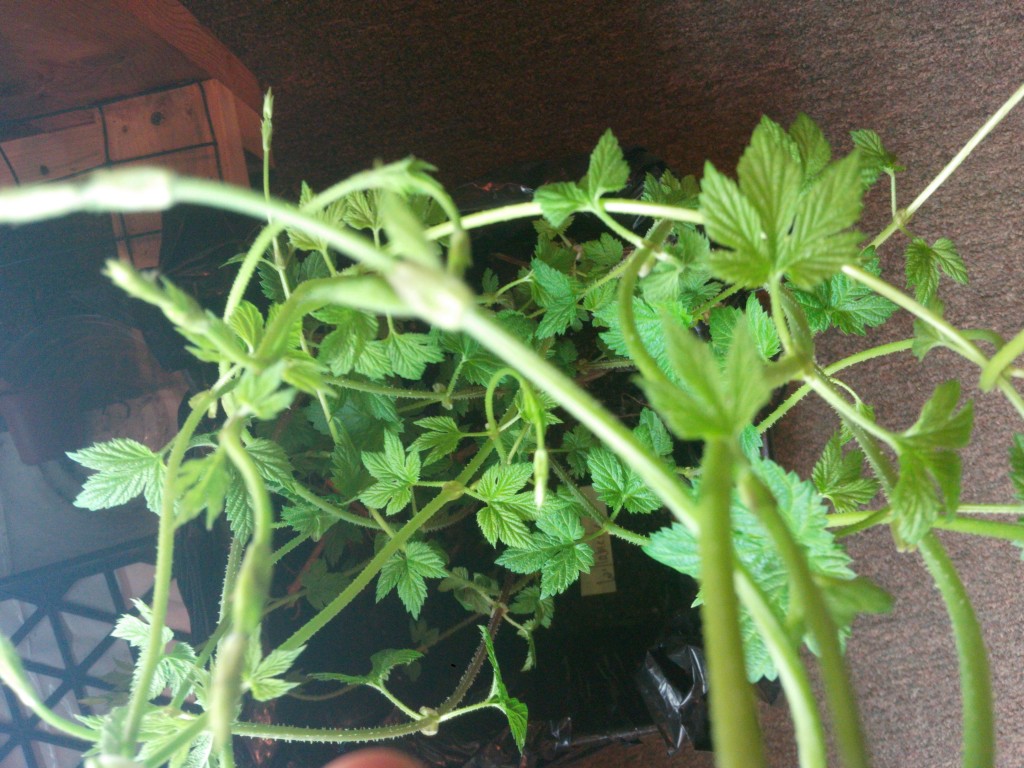 Growing hops can be an incredibly fulfilling undertaking on a number of levels. The most obvious benefit to growing hops is that you can make your own beer with them! However, there are myriad other uses for the hop plant. Hop shoots make an excellent addition to salads or light stir-fries, hop bines make for beautiful ornamental displays, and certain hop compounds are considered a sedative when consumed. If you find that you’re inclined to throw some rhizomes in the ground, then there are a few things you need to know first.
Growing hops can be an incredibly fulfilling undertaking on a number of levels. The most obvious benefit to growing hops is that you can make your own beer with them! However, there are myriad other uses for the hop plant. Hop shoots make an excellent addition to salads or light stir-fries, hop bines make for beautiful ornamental displays, and certain hop compounds are considered a sedative when consumed. If you find that you’re inclined to throw some rhizomes in the ground, then there are a few things you need to know first.
What’s a rhizome?
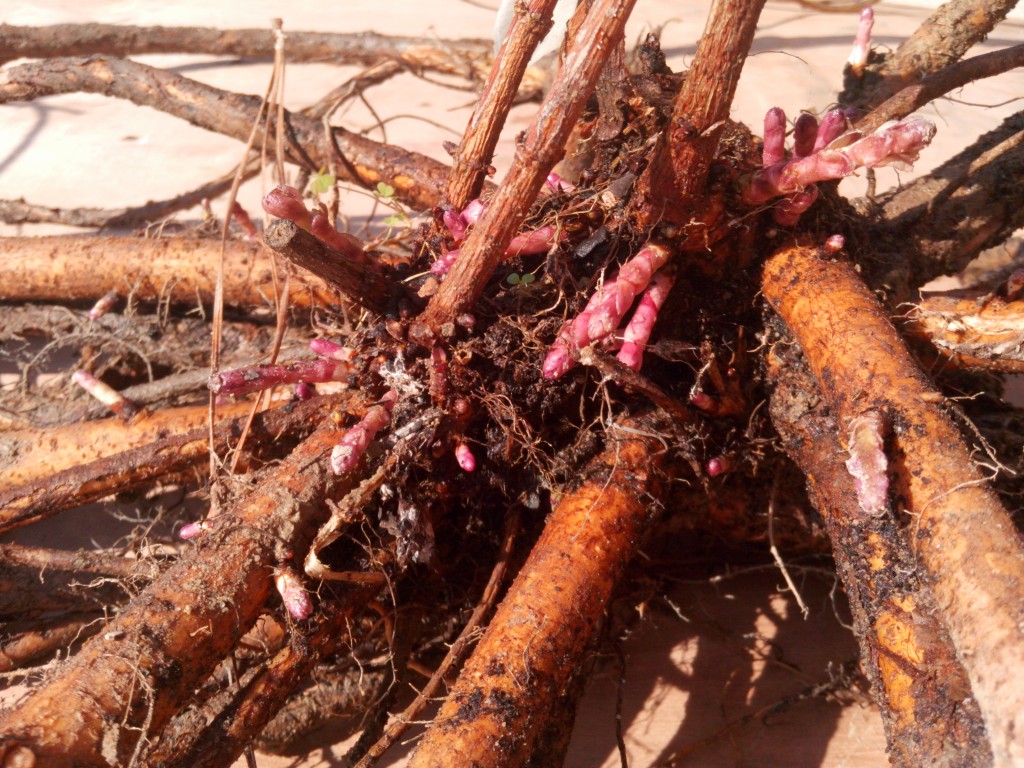 Every year that we offer hop rhizomes for sale, we inevitably get the question: “What is a rhizome?” The easiest way to answer this question is to compare typical plant growth and rhizomatic plant growth in simplified terms.
Every year that we offer hop rhizomes for sale, we inevitably get the question: “What is a rhizome?” The easiest way to answer this question is to compare typical plant growth and rhizomatic plant growth in simplified terms.
What we would consider a typical plant in this comparison has two sections: the root mass and the vegetative mass. The root mass serves to anchor the plant and act as an uptake for nutrients and water, and the vegetative mass is responsible for photosynthesis. The two are clearly defined and separated by the soil line.
In rhizomatic plant growth, there is a third piece to the puzzle. A rhizome is essentially a stem that exists underground and acts as an energy reserve for the bulk of the vegetative mass (Homegrown Hops, p. 31). Think of it like a tree branch growing underground and sending up branches through the soil.
The rhizome, for all intents and purposes, could be thought of as a part of the root structures, since roots do extend from the rhizome. However, it is technically considered to be an underground stem and conceptualizing it this way is paramount to the successful growth and care of your hop plant.
How to plant your hop rhizome
Hops, as a rule of thumb, aren’t very difficult to plant or maintain. However, there are a number of variables that you will need to be aware of that impact into how successful your hop planting will be and how much your plants will thrive. The first thing you will need to do is pick where you will be planting your hop rhizome, and the two biggest factors to take into account here are sunlight and drainage.
Your hop plant is going to want full sun exposure in order to thrive and grow to tis full potential. A hop plant has the potential to grow 20-30 feet in a season (Homegrown Hops, p. 13) and will need at least 6-8 hours of full sun a day to achieve this. You will also want to select an area that is naturally mounded, naturally sloped, or has been altered such that it drains more readily than its surroundings. The rhizome will want soil that remains moist, but drains well. They will also prefer to be in soil that has a pH of between 6 and 8. Properly mulching your hop bed will also help promote moisture retention and drainage with good balance.
Another factor to consider when planting your rhizome is where you will be training the bines. I’ve already mentioned that you can expect 20-30 feet of growth in a season, and you’ll want to have a plan for where that growth is going to go. There are a number of trellis systems that work well, or they can be trained to grow along a fence or up the side of a house. Also, keep in mind that they’ll need to be easily accessible if you plan on harvesting the cones. If you aren’t planning on harvesting your hops then you can simply plant them by a fence or other structure that they can climb naturally. They will grow very quickly and do very well at creating living barriers.
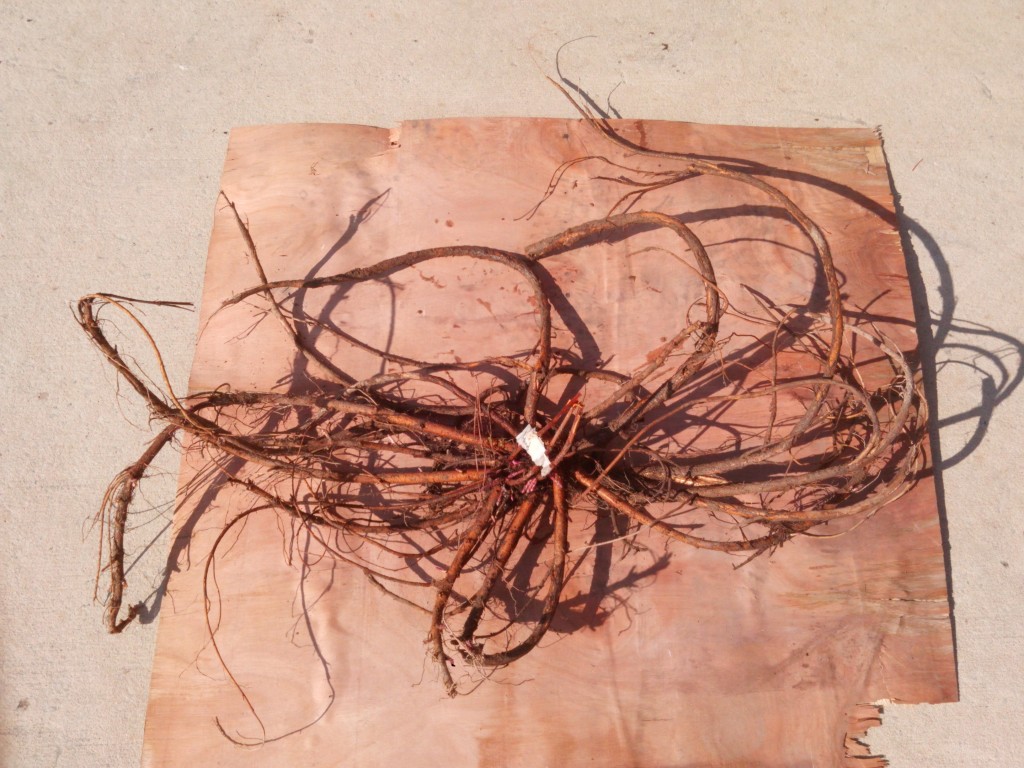
How to separate your rhizomes
We’ve already established that hops can grow a lot in a single season and it stands to reason that their rootstock will spread a fair amount as well. Turns out it does! So, if you want to keep your hop crown happy and healthy or ever want to add more hop plants, you’ll need to split it up every three years or so. The process of digging and splitting your hop crown seems much more daunting than it actually is. That being said, we decided to photograph a little step by step in order to take out some of the guesswork.
First things first, you’ll need to dig up your hop crown and check it out. The best time of year to do this is usually early to mid-March for the mid-Atlantic region. A good rule of thumb is to dig and split the plant before your first set of shoots is able to reach six inches in height (Homebrewer’s Garden, pg. 36). When you dig your rhizome be wary of the fact that it has probably spread a good bit in all directions. It helps to dig a few tentative holes and then establish which directions your main shoots are running so that you can be sure not to chop through them with a shovel.
Once you have your hop crown out of the ground it will look like a mass of roots with a thick central section. (Fig. 3) You will want to select a workspace that is large enough to contain the entire crown and doesn’t force you to hunch the entire time. A table or workbench usually serves the purpose well. Now that you have your hop crown spread out, you’ll want to begin identifying the harvestable sections of rhizome. We’ve found that it is usually easiest to separate large sections of rhizome from the main crown and break them down one at a time. (Fig. 4) If you look closely at Figure 4 then you will see that there are sections every 4-6 inches that are showing a bud or shoot. Those are the best candidates for a new rhizome (Fig. 5) and you can simply cut them with a pair of clean shears just past each shoot. Once you’ve broken down your crown, you will end up with a bunch of smaller sections of rhizome that look like chunks of root with buds coming off them (Fig 6). Not all viable rhizomes will be showing shoots so don’t be discouraged if some of your sections don’t have fresh growth showing. So long as the rhizome feels firm, doesn’t show any damage, and remains moist then you should be good to go!
Whether you’re planning on growing hops for brewing/culinary purposes, as a decorative addition to your property, or to help you chill out every now and then, you’ll want to have the foundation necessary to grow them well. If you follow the simple guidelines that we’ve set forth here, you’ll be primed for success. The only next step is getting some rhizomes, so stop by the nearest Fifth Season Gardening Co. before supplies run out!
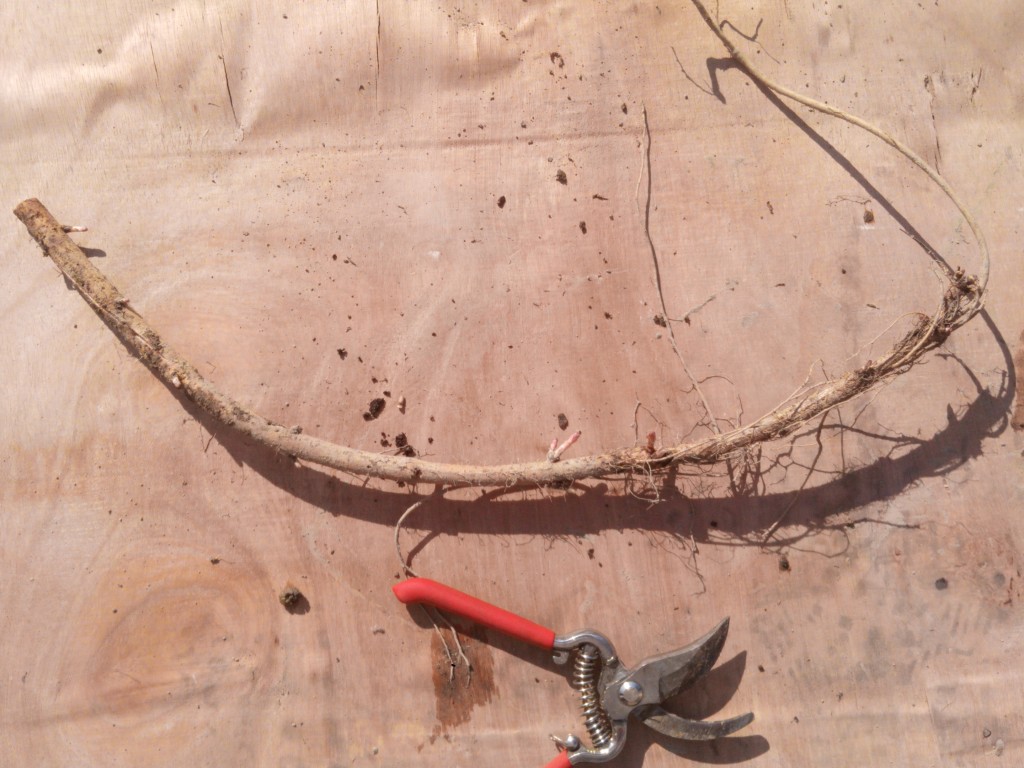
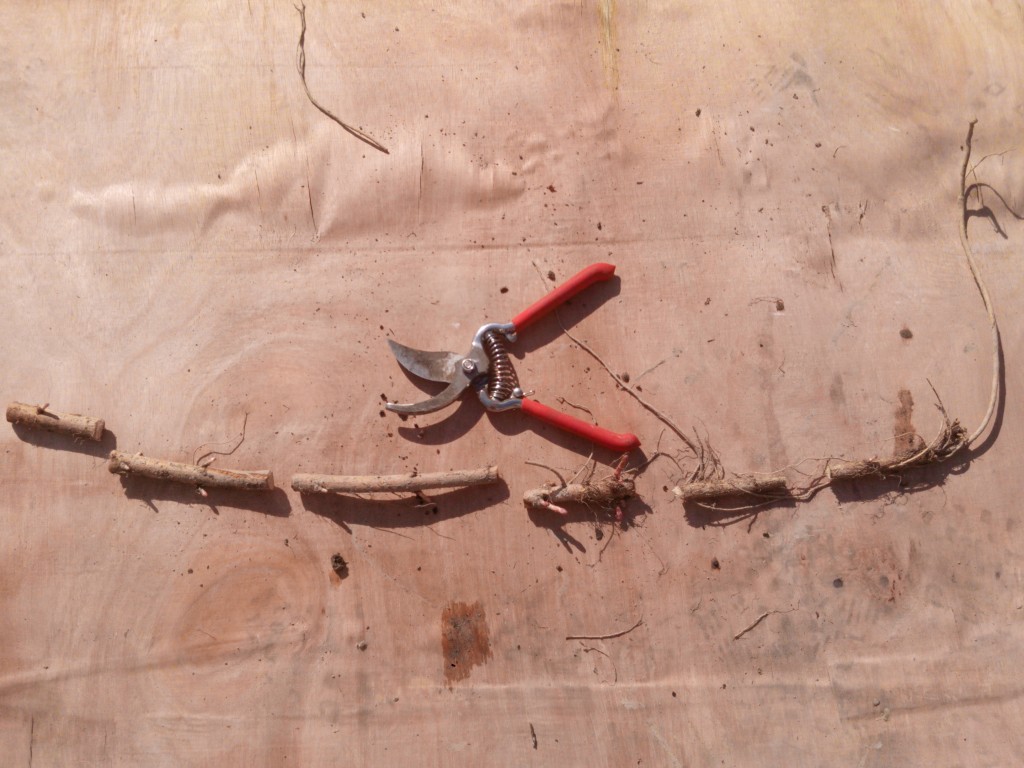
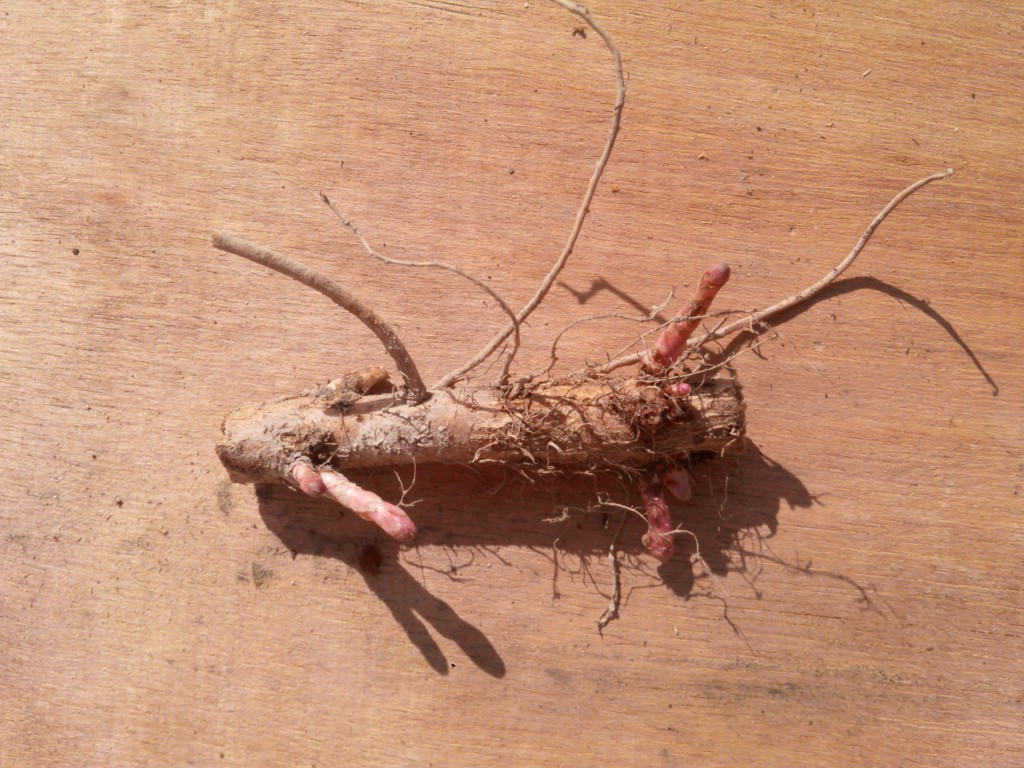

Sean C says
Thanks for the article. Are there specific hops varieties that perform better in the wet summers of North Carolina? What varieties does your store carry?
hamid says
hi dear
I want to plant hops plant in my backyard.
But in our country there is no seed or root.
Is your company can send me some seed or root?
thank you
Luc says
THANK YOU! So helpful and informative
Dave says
Thank you guys for creating such an informative resource about how to separate rhizomes. Really to appreciate the effort. Great photo references and descriptions. I was worried about this process and now I feel I can take it on… and have more hops!
Mark says
Hamid,
Hops are grown by root stock, the rhizome.
I have mine in a raised bed on the ground with landscaper’s cloth between it and the dirt under it. That will keep the roots contained and not spreading all over your garden bed. I also have a two story house for my heavy duty garden twine for it to grow on.
I have gotten 6-7 GALLONS of hops off my planting most years.
NeilP says
I’ve been happy, that with each year, my yield has been greater than the last one. If I dig the crown and separate out rhizomes, which part should I keep for myself? Should I leave the strongest buds and plant the whole crown or the thickest part of the rootstock?
ashley says
Hi Neil, Congrats on your hop growing success! We would recommend keeping the core crown and separating the rhizomes off of the structure that branches out from the crown. The crown will definitely have the most juice for the next season. If you think of the underground hop mass like a tree then consider the crown the trunk and the rhizomes the branches. You just want to trim the branches and keep the trunk.
Pamela Matson says
I have a fence around my septic field, would it be okay to plant hops against the fence, or would the roots go down to far into the ground and would cause trouble with roots in the weeping bed…
ashley says
Hi Pamela, Hops put out very deep root systems in their first year, and you usually see very limited production as a result of this. The resources I’ve read say that their root systems can extend to 15 feet (depth), and the rhizome definitely spreads laterally. They prefer well draining soil but need access to moisture and put out the super extensive root systems as a result of this. I’d say they could cause a problem but you would need to know the depth of your septic field and then consult a someone who works in septic systems to know for sure whether they would cause a problem. Hope this helps!
Jimmy says
what time of the year is the best time to purchase rhizomes? I see they’re only available at certain times of the year and ideally should be planted in spring so when do I buy ?
ashley says
Hop rhizomes are typically available in early spring. We usually do pre-orders in March, depending on when our suppliers tell us the rhizomes are ready to dig.
Frank says
Is it possible to cut from the second year. Or do i need to wait til the third year
ashley says
We would recommend waiting until the third year before digging your hop crown and splitting rhizomes off. In our opinion, if you were to dig and separate the crown every two years then you would be mitigating the plant’s ability to thrive. If the crown is being reduced that often then it won’t have the time to spread as much as it would normally, and the rhizomes you would be collecting would not be as substantial. If you give the crown another year then then there will be more rhizomes, the rhizomes will be larger and hardier, and the crown will have increased its ability to store energy for its dormancy period.
Kelly and Katie Fitzpatrick says
In response to franks question is harvesting the rhizomes before the start of your third growing season or after the third growing season before the forth.
Nick says
I’ve looked a number of places and can’t seem to figure this out. Do you have to cut the hops down every year? I’m looking for a vine to cover a pergola but want to keep it year round for some winter interest.
ashley says
Hi Nick,
Yes, they do have to be cut down each year. They’re deciduous perennial vines and the foliage does die back after production each fall. They would do well to cover a pergola from about May-September.
Nick says
Thanks for the response. I’m not interested in collecting the hops so if I left the vines alone would they just drop the leaves and hops? Then in spring regrow them? I’m looking for something I can leave up over winter.
ashley says
The whole vine dies back to the ground, so you’ll have to cut it back to remove the dead material every year, making it not such a good vine for a pergola. I’d suggest maybe a native wisteria if you are looking for something that will go for years. It is also deciduous, but it is a woody vine that grows new branches, leaves, and flowers from the previous year’s growth. So, during winter, your pergola will (eventually)have branches covering it, but then will leaf out and flower during spring, and be green during summer. I would NOT plant invasive Asian Wisteria, but only our native. Other native vines that are nice are Lonicera Sempervirens (a native evergreen honeysuckle) and Bignonia capreolata (cross vine – another evergreen (in the south) with pretty flowers).
Nick says
Awesome! Thanks so much I’ve looked and looked online for that info and never found it. Native wisteria was on my list as well and I think it might be the winner. I have fond memories of my great aunts grape vines she had covering her patio and want to replicate that.
jeon hyocheol says
Hello.
I am preparing for hop cultivation in Korea.
I want to receive your hoprhizomes
I intend to import 1000 of you.
I want you to let me know what to do.
thank you
ashley says
Unfortunately, we are unable to ship rhizomes overseas. Best of luck finding a more local source!
Doug says
What is the best way to store cut prepared rhizomes over the winter months to ensure a good rhizome to plant in the spring?
ashley says
Hi Doug, We got in touch with one of our local Hop growers to get their advice, and here’s what they told us: We do not recommend planting rhizomes in the ground now as they will be dormant and probably rot. Ideally, the rhizomes wouldn’t be pulled/cut now and that would be done in the Spring. If you were to try to hold them over the winter for spring planting the recommendation for best chance of success is to pat the rhizome dry with a paper towel, place it in a clean ziplock, and include a damp paper towel to maintain humidity. Check periodically (1-2 weeks) to ensure the paper towel is still damp. For another reference on growing hops, you can also try this Facebook forum for info: hop growers forum (nationwide). Hope this helps!
David says
Hi, I live in Cairns, Qld and last year successfully grew 4 different types of hops. (Willamette, Cascade, Victoria & Saaz) I planted them around May (winter time, so not quite as hot as summer, but shorter days) and within 4 months they’d grown close to 5m. I grew them in pots, watered and fed well and all has been good. They flowered and I’ve used the hops in a couple of my homebrews. There’s not too much lupulin, but they smell great and aromatically work well in the beer (I have no idea how to measure the Alpha/Beta acids re bitterness).
Can you please advise me on when I should give the plants a rest? – ie take them out of the pots and wrap in damp newspaper and put in the fridge….or should I just leave them in the pots to do their thing? There’s no real winter here, it’s either hot and dry, or hot and wet…..Cairns latitude is way out of the recommended but nature seems to cope when needed! Thanks and btw, a great site you have. Cheers.
ashley says
Hi David, Here is some advice from our chief brewing expert, Ethan …
I would refer them to the Australian Independent Hop Growers Forum on Facebook for advice on hop seasons in that part of the world. It’s totally different from the Northern Hemisphere practices.
To my knowledge, there shouldn’t be a need for them to be pulled from the pot and rested in a fridge. It would be advisable to remove the rhizome crown every 3-5 years (roughly) and divide it or trim the rhizome stock back. Then he could place the cut rhizomes in the fridge for a bit to store if he didn’t want to plant them soon.
The only way to measure alpha/beta acid is to send it off to a lab for analysis. Otherwise, you have to go by the expected ranges for the variety. Most folks advise aromatic use for that reason.
Mike Shippen says
Hello,
How often are new shoots formed on the rhizome? Does this continue throughout the growing season? To harvest the shoots, am I limited to initial cutting at the beginning of the growing season or will I be able to continually harvest them?
-Thanks,
Mike
ashley says
Hi Mike, New shoots are formed during spring when the rhizome comes out of dormancy. The number of shoots will depend on the age/size of the crown etc… They can’t, generally, be continuously harvested, as the plant will eventually stop producing them. The best time to harvest them will be the youngest shoots that sprout in the spring. I would allow 1-3 main bines to develop and trim the rest of the shoots. It’s kind of a spring delicacy.
Cheers – Ethan
Amber says
We live in Oregon. Plants are starting to come up. Maybe an inch in places. Our Hops were here when we moved in about ten years ago. They are super healthy and happy. It shoots out into our garden. I am mostly fine with it being there. But we are wanting some in another spot. My question is can I dig into the ground and sort through what ever I find to plant without damaging the whole plant? No way I could dig our beast up in its entirety.
ashley says
Hi Amber,
If your hop plant has only just started coming up then you can dig up some of the rhizomes running away from the crown and cut it wherever there are buds forming, in order to divide and transplant it. You’ll want to identify where it’s sending up sprouts away from the center (crown) and dig up that runner. Then you can cut it into segments wherever it’s budding and transplant those. Cheers – Ethan
Matt says
Howdy!
Thanks for the good info. I did have a question on what is generally done to the crown after rhizomes are harvested. Is the crown replanted, or is it a total dismemberment? If it is replanted how is the yield affected with the tap root being severed? Is harvesting some rhizomes while leaving the core of the crown in the ground feasible?
Despite a few first year setbacks here in Montana (frost, deer, late planting, twine breaking, wind damage, aphids, etc) I had a successful harvest of not quite 1 pound dried hops per plant. Just going into the second growing season on my 16 plants so I have a bit of time before harvesting rhizomes, but I’m always curious.
Thanks,
Matt
ashley says
Hey Matt, The crown doesn’t necessarily have to be dug in order to harvest rhizomes. Runners can be identified and cut that way OR the crown can be dug and rhizomes cut off of it. I would generally recommend replanting the entire crown. It stands to reason that yield would be negatively affected, but this shouldn’t be happening but every few years, if then. Our hop farms aren’t going through and digging every one of their crowns and replanting them. They’re pulling rhizomes from the periphery.
I would also recommend the Hop Growers Forum USA on Facebook as a resource.
Cheers – Ethan
Matt says
Thanks, Ethan!
Robert says
Hello
I live in the south región of Chile, the Araucania.
I plan to plant hops here, the climate seems to be similar to that of Pacific West Coast, so I am positive about them growing here.
The seasons here, however, areother way around – when northern hemisphere enters spring, here starts the fall and then winter (lower temps but never below zero Celsius and lots of rain). How do I plan to bring rhizomes from Europe or the States and plant them? When could I do that?
Cheers,
Robert
ashley says
Hi Robert,
I would think the best option for you would be to try to find a relatively local source for hops rhizomes, since, as you note, when we in the Northern Hemisphere are digging hops rhizomes for planting in the spring, you are entering the fall. I would suggest checking out the Facebook “Hop Growers Forum” which may give you some leads on hop growers you could contact.
Thomas Turner says
Thank you for all the wonderful info. ! I have been brewing beer for over thirty years – mainly extract, but this year I started all grain and now i find the most expensive ingredient are the hops. In order to keep my costs down I ordered 10 varieties of hop rhisomes and plan on ” growing my own”. I wanted to see which varieties are best suited to my location hence the large variety. I live on the south shore of Nova Scotia and have a 5 month growing season- May to Sept. My issue is that I have a long fence that runs along the edge of a septic field – a perfect location for my hops as its full sun all day and the bines could travel along the fence. The problem is that I don’t want to dig into the ground around the septic field so I guess my best bet is to either use a raised bed or large planters. Where it gets quite cold here in the winter ( -15 C ) for extended periods I’m not sure if I could leave the hop roots in the ground all winter in a pot or a raised bed. Can I dig them up and leave them dormant in a warm spot for the winter like a bulb or do they have to stay in the soil? Thank you, Thomas.
ashley says
Hi Thomas,
The best advice we can give you would be to look for a hop-growing forum based in Canada, and lay out your issue to them. Facebook has a number of hop-growing groups that you could search for. Our growing conditions down here in the southern US are so vastly different from yours, we wouldn’t want to advise you incorrectly. Best of luck!
Krissa Bolton says
We live in Park City UT where there are a lot of wild hops that grow over-up and down walls with no fencing. As I would like to grow hops- I understand that the deer don’t eat them like all the other vines in my garden. So I am wondering if cultivated hops can grow in similar conditions as wild hops? Thanks
ashley says
Krissa,
It must be so cool to have wild hops growing everywhere! In general, deer don’t really bother hops. However, I will say that sometimes deer and rabbits will “test” new growth on the hop shoots but generally don’t bother them afterwards. You should expect cultivated hops to tolerate conditions very similar to wild hops if they’re the same species. Most of the hops we are familiar with are Humulus lupuls v. lupulus and I would assume that’s what you’re seeing since they’re climbing etc… There is also Humulus lupulus v. neomexicanus but those tend to crawl and not climb so easily. There is also Humulus japonicus and other related species. However, those are not common in the US and certainly not wild. So, I feel as though you should expect similar growth from cultivated hops.
Cheers
Ethan
Carol says
I planted hops from seeds germinated over a period of several months in my refrigerator here in Homer Alaska three years ago. I managed to nurture three seedlings into transplantable size and get them in the ground. The first summer they accomplished ten to twelve feet in height, the last two they are reaching up more like twenty and have enveloped our little garden shed inside and out. They are gorgeous plants very dramatic and satisfying to the eye. The three original plants are quite close together 24 inches or so apart which now seems decidedly close although they seem quite happy as they are. I want to plant them in other spots and provide rhizomes to friends and family without unduly disturbing these three happy plants. Should this be done now as the growing season winds down here or must I wait till Spring? Thanks for all your information! It is generous and useful! Carol
ashley says
Hi Carol, the rule of thumb on dividing crowns is that it’s best done in spring. I would wait until the very beginning of the spring season when they start to break dormancy and divide the crown then. And you’re right, they definitely need to be more than 24 inches apart – they get big! Cheers – Ethan
Mark says
Hi
I planted a new rhizome and the shoots got massavred by slugs. As a last resort i replanted it elsewhere and less slug friendly. Unfortunately it didnt grow back at all. My question is have I killed it…..or might i come back next year??
Mark
ashley says
Hi Mark, It’s hard to say in that situation. Ideally, you would have seen growth after you replanted it in a new area. There is a good chance that the rhizome spent all of its energy rooting the first go around and was unable to recover from having its roots consumed and then replanting. However, the only real way to know would be to A) dig it up to check or B) wait until the Spring to see if it comes back. Option A would probably kill the plant at this point, if it were alive. Your best bet is to just wait and see if it comes back, and to order some more rhizomes from us if it doesn’t!
Dave says
Hello, and thanks for the excellent right up. I have an opportunity to aquire some rhizomes for free from a neighbor. But being as it’s late summer here in northern Wisconsin, I don’t know if I can store them over winter, or should I transplant them now? They will not be available in the spring. Thanks.
ashley says
Hmmmm, that one’s tricky. I would have to question whether or not there’s enough of a season left in Wisconsin for a rhizome to be planted and establish a robust enough rootstock to survive your winter. My recommendation would be to plant them in containers for now. Then you can pop them in the ground when spring is starting to hit up there. If you’re getting multiple rhizomes then you could certainly try putting one in the ground right now. I’m just reticent to say that it would have a strong chance of surviving the cold up there without being able to really get itself established.
Rusty says
Thanks for the great
Information! I have 4 verities of hops going into my 5th year. I would
Like to dig some Rizomes
Next spring to plant more.
George Steplock says
I’m trying to rid my garden of an ornamental hop. I have removed the plant ball and several of the roots. Some roots are too difficult to remove. Will these roots regenerate ?
I ask because I now have some beer hops to plant and I am reluctant but hoping I can plant them in the same spot. But if the ornamental regenerates then I don’t want the 2 hops growing in the same spot and confusing what is what.
ashley says
Hi George, It’s hard to say since hops grow and spread by rhizome. It is possible that the hop can regrow if an adequate portion of rhizome is still present in the ground; however, those plants would start showing soon and they would be coming up in places other than where the crown you dug out was located. So, you should be able to plant other hops in the original spot where you dug out the ornamentals, and they won’t spread significantly underground this year, so anything that comes up somewhere else would be the ornamental one. Hope this helps – cheers! Ethan at FSG
Mark Helm says
I need to move a plant to install a pole between 2 poles I already have installed. Could I remove the plant and separate till planting season ? Do I refrigerate or keep in basement in dark area in baggy with moist towel ?
Thanks
Mark
ashley says
I think you’d be better off just transplanting it now instead of trying to keep it unplanted until spring. I don’t think there’d be much of a chance of it surviving that amount of time out of the ground. My general advice would be to transplant it into a well draining area and try to give it some time to reestablish this fall. Best of luck! — Ethan at Fifth Season Gardening